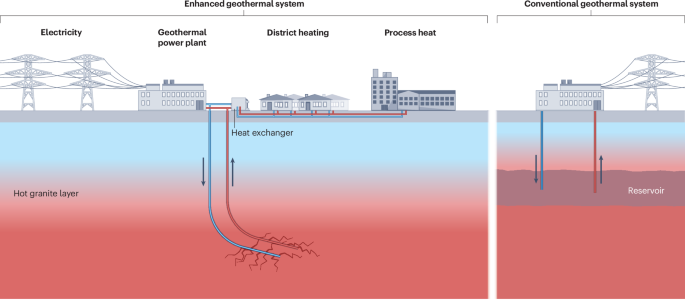185
Enhanced geothermal systems for clean firm energy generation | Nature Reviews Clean Technology
www.nature.comGeothermal energy provides clean, steady and renewable electricity and heat, but the use of geothermal energy has conventionally been constrained to locations with adequate subsurface heat and fluid flow. Enhanced geothermal systems (EGS) enable geothermal energy usage in unconventional areas by enhancing the subsurface permeability and increasing fluid flow, which is then extracted as a carrier of the thermal energy. In this Review, we discuss the development of EGS and its role in providing energy. Some EGS are operating commercially in Europe and provide heat and/or electricity, but technical issues and concerns over induced seismicity have historically hindered the broader expansion of EGS. Adaptation of advanced drilling techniques (including the use of polycrystalline diamond compact bits, multiwell drilling pads, horizontal drilling and multistage stimulation) is enabling an increase in scale and decrease in cost of EGS projects. As a result, in the USA, enhanced geothermal is expected to achieve plant capital costs (US$4,500 kW−1) and a levelized cost of electricity (US$80 MWh−1) that are competitive with market electricity prices by 2027. With further development of EGS to manage induced seismicity risk and increase system flexibility, EGS could provide stable baseload and potentially dispatchable electricity in clean energy systems. Enhanced geothermal systems can provide clean energy in areas where conventional geothermal systems are not viable. This Review discusses energy production through these systems and the technological developments that could enable its future expansion.



Lol.
you find someplace to put or neutralize that plutonium 235 half life of 24,000 years, then you can chuckle fucknuts
I wish we had invested more in fast breeder reactors 50 years ago, because then we’d be burning up most of our waste, and the small fraction of high grade waste we’d have left over would become safe in decades, not millennia.
Like, we only extract 10% of the energy present in our nuclear fuel, and that gives us all this fucking kiloyear half-life nuclear waste that we have to bury. The small amount of waste from a fast breeder reactor produces hideously powerful radiation, but it works its way down the decay chain fast. I think it’s safe in decades, although it might be as long as a couple of centuries. Still a long damn time, but it’s orders of magnitude better than low and medium-grade waste. ~The amount is genuinely much less, because far more of the fuel goes through e=mc². It can’t be radioactive waste if it’s been converted into energy.~ (EDIT: FBRs produce waste in quantities two order of magnitude lower than a standard light water reactor. 100x less, and it’s safe within human timescales.)
People were making good progress towards commercially viable breeder reactors in the 60s, but then we found more uranium and got better at enriching it and people just gave up. Modern attempts have failed for whatever reasons most modern reactor designs have been problematic. I feel like the climate situation might be a bit less from if people had just stuck with developing FBRs instead of being shortsighted idiots. It’s not going to help us now, so I’m really glad we’ve gotten so good at making geothermal work most places.
EDIT: my explanation for why FBRs have less waste is not correct. See the replies for a more correct explanation.
I’m not sure this makes sense. The conclusion might be right, but I don’t think the explanation is. Matter isn’t being annihilated in nuclear fission. The number of protons and neutrons at the start is the same as at the end. The reduced mass is a result of increased binding energy.
At least, that’s how I remember it from highschool physics. I find this stuff fascinating so I’d love to hear an explanation of how it’s wrong or overly simplified, if so.
AFAIK, the number of protons and neutrons is the same, but the overall mass is reduced because the binding energy holding the nucleus together counts towards the mass. I do not understand why the binding energy acts as mass (I dropped out of physics after moving past classical mechanics), but that’s what’s I’ve heard over the years.
So basically, you have it right, and my explanation is overly simplified because I am not very competent and forgot how this shit worked lol. I remembered that the overall mass of the waste is lower than what was put in, but I fucked up when explaining why that happens. Breeder reactors can’t do much with the fission products themselves, but the worst part of nuclear waste from a long-term storage perspective is the transuranics that get created inside of a reactor. FBRs make a lot of neutrons that can transmute those transuranics into fissile materials and then burn them up, extracting the binding energy from them and reducing the overall mass. Eventually you’re just left with fission products which are generally very short lived.
EDIT: I accidentally hit post way too soon, so I wrote most of this as an edit. Apologies for that.